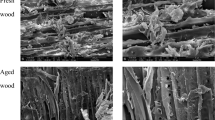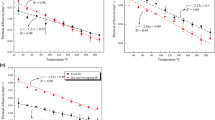Abstract
Over the past years, multiple fire accidents have been witnessed in ancient wooden buildings around the world, thereby causing major losses of cultural relics and social impact. Because of the damage of the ancient wood structure caused by the problem of aging, this enables its thermal conduction properties to change. For this reason, the way how the fire spread also changes. This study was based on the concept that the environmental characteristics of ancient building wood subjected to long-term natural aging, and so the artificially accelerated and alternate process of dry and wet aging method used for wood materials was determined. To that end, the common wood types of ancient buildings were selected as the research objects, so as to obtain the varying degrees of dry and wet aging wood materials. Furthermore, the characteristics of pores on the outer surface of aging wood materials were analyzed through the experiments conducted with a scanning electron microscope. Through the thermophysical property test, the variation law of thermophysical property parameters of aging wood materials with temperature was appraised, and the influence mechanism of the alternate process of dry–wet aging on the thermal conductivity of wood was revealed. The results demonstrated that the cell wall of wood underwent plastic deformation during the alternate process of dry and wet aging. Also, the local wood structure collapsed to different degrees, and so the surface tear degree increased. Because of the joint influence of the elastic stress and the mechanical adsorbed creep stress generated in the alternate process of dry and wet aging, the surface pore deformation of wood was periodic and dampened with the aging degree, so that the heat conduction properties of wood all manifested the change law of sinusoidal damping with the deepening of the aging degree. It is hoped that the research results could provide a theoretical basis for both the early prediction about and the accurate warning of fire spread in ancient wooden structures.

















Similar content being viewed by others
References
Salazar L, Romo X, Paupério E. Review of vulnerability indicators for fire risk assessment in cultural heritage. Int J Disaster Risk Reduct. 2021;60(5):102286.
Wang K, Wang DZ, Zhou B, Yang WY, Wang JT, Wang W, et al. Influence of air gap ratio of the Chinese historical wooden window on the vertical flame spread performance. Therm Sci Eng Prog. 2022;32:101308.
Garcia-Castillo E, Paya-Zaforteza I, Hospitaler A. Analysis of the fire resistance of timber jack arch flooring systems used in historical buildings. Eng Struct. 2021;243:112679.
Caliendo C, Ciambelli P, Del RR, Meo MG, Russo P. Modelling and numerical simulation of pedestrian flow evacuation from a multi-storey historical building in the event of fire applying safety engineering tools. J Cult Herit. 2020;41:188–99.
Allonneau A, Mercier S, Maurin O, Robardet R, Fleuriot AM, Luu SC. Lead contamination among Paris Fire Brigade firefighters who fought the Notre Dame Cathedral fire in Paris. Int J Hyg Environ Health. 2021;233:113707.
Chorlton B, Gales J. Fire performance of cultural heritage and contemporary timbers. Eng Struct. 2019;201:109739.
Arpaci S, Tomak E, Ermeydan M, Yildirim I. Natural weathering of sixteen wood species: changes on surface properties. Polym Degrad Stab. 2021;183:109415.
Kránitz K, Sonderegger W, Bues CT, Niemz P. Effects of aging on wood: a literature review. Wood Sci Technol. 2016;50:7–22.
Froidevaux J, Navi P. Aging law of spruce wood. Wood Mater Sci Eng. 2013;8(1):46–52.
Mi XC, Li TY, Wang JP, Hu YF. Evaluation of salt-Induced damage to aged wood of historical wooden buildings. Int J Anal Chem. 2020. https://doi.org/10.1155/2020/8873713.
Li J, Bohumil K. Effects of thermal aging on the adhesion forces of biopolymers of wood cell walls. Biomacromolecules. 2022;23(4):1601–9.
Carrillo M, Carreón H. Study of the degradation effects on aged wood beams from the cathedral of Morelia, Mexico by acoustic birefringence measurements. Russ J Nondestruct Test. 2021;56(12):1042–9.
Sonderegger W, Kránitz K, Bues CT, Niemz P. Aging effects on physical and mechanical properties of spruce, fir and oak wood. J Cult Herit. 2015;16(6):883–9.
Han LY, Wang K, Wang WB, Guo J, Zhou HB. Nanomechanical and topochemical changes in elm wood from ancient timber constructions in relation to natural aging. Materials. 2019;12(5):786.
Murat A, Tuğba YA. Moisture dependent elastic properties of naturally aged black pine wood. Constr Build Mater. 2020;262(1):120752.
Kránitz K, Deublein M, Niemz P. Determination of dynamic elastic moduli and shear moduli of aged wood by means of ultrasonic devices. Mater Struct. 2014;47(6):925–36.
Zupanc MŽ, Lesar B, Humar M. Changes in moisture performance of wood after weathering. Constr Build Mater. 2018;193:529–38.
Baranski J. Moisture content during and after high-and normal-temperature drying processes of wood. Dry Technol. 2018;36(6):751–61.
He ZB, Qian J, Qu LJ, Wang ZY, Yi SL. Simulation of moisture transfer during wood vacuum drying. Results Phys. 2019;12:1299–303.
Vololonirina O, Coutand M, Perrin B. Characterization of hygrothermal properties of wood-based products-Impact of moisture content and temperature. Constr Build Mater. 2014;63:223–33.
Suchomelová P, Trcala M, Tippner J. Numerical simulations of coupled moisture and heat transfer in wood during kiln drying: influence of material nonlinearity. BioResources. 2019;14(4):9786–805.
He G, Yan N. Effect of moisture content on curing kinetics of pMDI resin and wood mixtures. Int J Adhes Adhes. 2005;25(5):450–5.
Ito Y, Tanahashi M, Shigematsu M. Compressive-molding of wood by high-pressure steam-ttreatment: part 2. Mechanism of permanent fixation. Holzforschung. 1998;52(2):217–21.
Toba K, Nakai T, Kanbayashi T, Saito H. Effects of cyclic drying and moistening on the mechanical and physical properties of wood. Eur J Wood Wood Prod. 2022;80:1333–41.
Fu WL, Guan HY, Kei S. Effects of moisture content and grain direction on the elastic properties of beech wood based on experiment and finite element method. Forests. 2021;12(5):610.
Gong JH, Cao JL, Zhai CJ, Wang ZR. Effect of moisture content on thermal decomposition and autoignition of wood under power-law thermal radiation. Appl Therm Eng. 2020;179:115651.
Hasan MDM, Hu X, Gunawan R, Li CZ. Pyrolysis of large mallee wood particles: temperature gradients within a pyrolyzing particle and effects of moisture content. Fuel Process Technol. 2017;158:163–71.
Kuznetsov GV, Syrodoy SV, Nigay NA, Maksimov VI, Gutareva NY. Features of the processes of heat and mass transfer when drying a large thickness layer of wood biomass. Renew Energy. 2021;169:498–511.
Liu MB, Sun YF, Sun C, Yang XL. Study on thermal insulation and heat transfer properties of wood frame walls. Wood Res. 2018;63(2):249–60.
Zhu YH, Zhang YL, Pan B. Thermal conductivity and deformation of taxodium hybrid ‘Zhongshanshan’ during heat transfer process. BioResources. 2020;15(2):2645–55.
Yang SM, Kwon JH, Kim PL. Analysis of heat transfer characteristics by material based on closed conditions using acrylic hemispheres (II): comparison by type of building structural materials. J Korean Wood Sci Tech. 2020;48(5):710–21.
Kang SG, Lee S, Son DW, Kang CW, Matsumura JJ. A study on heat transfer of paulownia coreana and high-density fiberboard via comparative analysis. J Fac Agric Kyushu Univ. 2015;19(2):693–702.
Hortobágyi Á, Pivarčiová E, Koleda P. Holographic interferometry for measuring the effect of thermal modification on wood thermal properties. Appl Sci. 2021;11(6):2516.
Korkut S, Aytin A, TasdemiR C, Gurau L. The transverse thermal conductivity coefficients of wild cherry wood heat-treated using the thermo wood method. ProLigno. 2013;9(4):649–83.
Kol HS, Sefil Y. The thermal conductivity of fir and beech wood heat treated at 170, 180, 190, 200, and 210 °C. J Appl Polym Sci. 2011;121(4):2473–80.
Dedic A. Simplifying convective heat and mass transfer in moisture desorption of beech wood by introducing characteristic transfer coefficients. Holz Roh Werkst. 2000;58(1):96–101.
Merlin S, Romain R, Yann R, André Z, Beguide B. Modeling of coupled heat and mass transfer during drying of tropical woods. Int J Thermal Sci. 2016;109:299–308.
Dedic AD, Svrzic SV, Janevski JN. Three-dimensional model for heat and mass transfer during convective drying of wood with microwave heating. J Porous Media. 2018;21(10):877–86.
Parker WJ, Jenkins RJ. Thermal conductivity measurements on bismuth telluride in the presence of a 2 MeV electron beam. Adv Energy Convers. 1962;2:87–103.
Cowan RD. Proposed method of measuring thermal diffusivity at high temperatures. J Appl Phys. 1961;32(7):1363–70.
Cowan RD. Pulse method of measuring thermal diffusivity at high temperatures. J Appl Phys. 1963;34(4):926–7.
Plumb PA, Spolek CA, Olmstead BA. Heat and mass transfer in wood during drying. Int J Heat Mass Transf. 1985;28(9):1669–78.
Acknowledgements
This study was sponsored by the Young Elite Scientists Sponsorship Program of China Association for Science and Technology (Grant no. 2021QNRC001).
Author information
Authors and Affiliations
Corresponding author
Additional information
Publisher's Note
Springer Nature remains neutral with regard to jurisdictional claims in published maps and institutional affiliations.
Rights and permissions
Springer Nature or its licensor (e.g. a society or other partner) holds exclusive rights to this article under a publishing agreement with the author(s) or other rightsholder(s); author self-archiving of the accepted manuscript version of this article is solely governed by the terms of such publishing agreement and applicable law.
About this article
Cite this article
Song, J., Deng, J., Zhao, J. et al. Influence mechanism of dry and wet alternate aging on thermal property characteristics of wood. J Therm Anal Calorim 148, 5111–5129 (2023). https://doi.org/10.1007/s10973-023-12015-5
Received:
Accepted:
Published:
Issue Date:
DOI: https://doi.org/10.1007/s10973-023-12015-5




